#Kichiemon Nakamura
Photo

Meiko Kaji (梶芽衣子) and Kichiemon Nakamura (二代目 中村 吉右衛門) in the 1995 Onihei Hankacho (鬼平犯科帳) movie.
#Meiko Kaji#梶芽衣子#Kichiemon Nakamura#Onihei Hankacho#二代目 中村 吉右衛門#鬼平犯科帳#Onihei Hankacho movie#press photo
26 notes
·
View notes
Text

3 notes
·
View notes
Text

Happy 82nd, Shima Iwashita.
With Kichiemon Nakamura in Masahiro Shinoda’s Double Suicide (1969).
11 notes
·
View notes
Photo

“This is all very troublesome.”
Kuroneko (aka The Black Cat, Kaneto Shindo, 1968)
5 notes
·
View notes
Photo
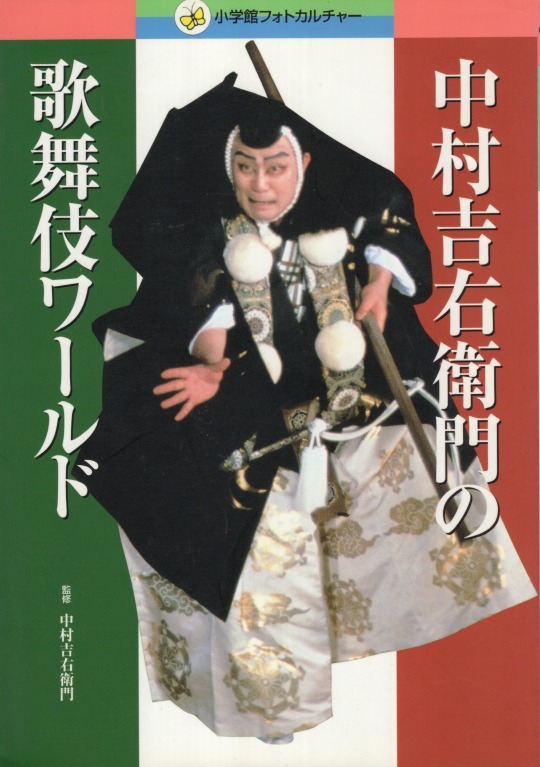
中村吉右衛門の歌舞伎ワールド
小学館フォトカルチャー
監修・中村吉右衛門、文・構成=おくだ健太郎
小学館
#中村吉右衛門の歌舞伎ワールド#kichiemon nakamura#中村吉右衛門#小学館フォトカルチャー#kentaro okuda#おくだ健太郎#anamon#古本���あなもん#あなもん#book cover
5 notes
·
View notes
Photo
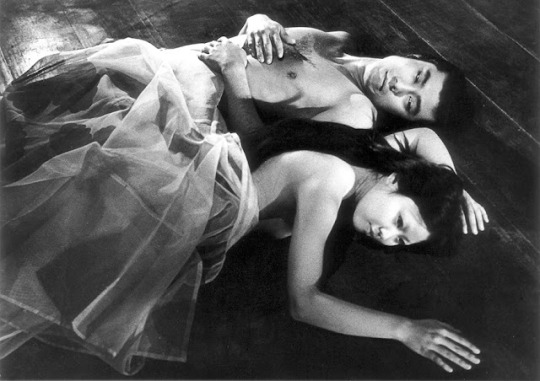
Kichiemon Nakamura and Kiwako Taichi in Kuroneko (Kaneto Shindo, 1968)
Cast: Kichiemon Nakamura, Nobuko Otowa, Kiwako Taichi, Kei Sato. Screenplay: Kaneto Shindo. Cinematography: Norimichi Igawa, Kiyomi Kuroda. Art direction: Takashi Marumo. Film editing: Hisao Enoki. Music: Hikaru Hayashi.
Sometimes mood is everything, especially in a ghost story. The film that starts creepy and stays creepy tests our tolerance for creepiness. Kaneto Shindo seems to know this. He starts Kuroneko with a peaceful pastoral scene: a hut with a small brook running past its door, and in the distance fields backed by the wall of a forest. He lingers on this scene just long enough for it to register on us before ragged samurai begin to emerge from the forest, approach the brook in front of the hut, and drink thirstily from it. Then he cuts to the inside, where two terrified woman are watching the approach of the samurai, who enter the hut, pillage it, rape and murder the women, and set fire to the hut. Then we cut to the opening frame as the samurai return to the forest and smoke begins to billow from the hut. It blazes up, and Shindo cuts to the aftermath: the ruins of the hut and the bodies of the women, strangely unconsumed by the fire. A black cat enters and sniffs around the women, then begins to lick their wounds. Then it's nighttime, and the scene changes to the Rajomon (or Rashomon) Gate in Kyoto, where the supernatural story begins: The women are now ghosts, their former rags replaced by fine garments, who lure the samurai who violated and killed them to their handsome dwelling in a bamboo grove, where they bite out their throats and drink their blood. Shindo is masterly at setting up a plausibly real opening and slowly transitioning to the eerie vengeance of the dead women, who seem to float and sometimes move with, well, catlike grace. News of the deaths of the samurai reaches the emperor, who orders the chief samurai, Raiko (Kei Sato), to deal with the problem. We then cut to a fight between a young soldier (Kichiemon Nakamura) and a huge man armed with an iron-studded club. The soldier vanquishes the big man, cuts off his head, and rides home to bring the news that he's the only survivor of a battle. Raiko rewards the soldier by making him a samurai and giving him the name Gintoki. The interpolation of the fight scene and Gintoki's ride again break the mood, providing a welcome contrast with the ghost scenes. Proudly, Gintoki goes to see his wife and his mother, only to find the ruins of their hut -- they were, of course, the victims of the marauding samurai. And Raiko then orders Gintoki to prove his valor by finding and killing the "monster" that has been slaughtering his samurai. Eventually, of course, Gintoki will discover that the killers are the ghosts of his wife, Shige (Kiwako Taichi), and his mother, Yone (Nobuko Otowa), setting up an impossible moral dilemma. It's a tense, beautifully photographed, often surprisingly erotic, and subtly terrifying film that even I, usually immune to the shocks of horror movies, can appreciate.
3 notes
·
View notes
Text


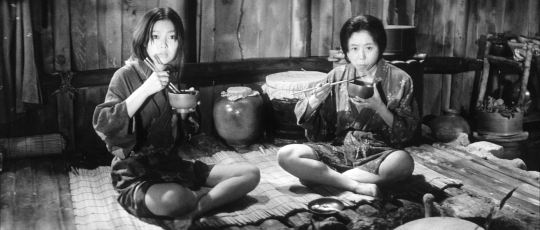

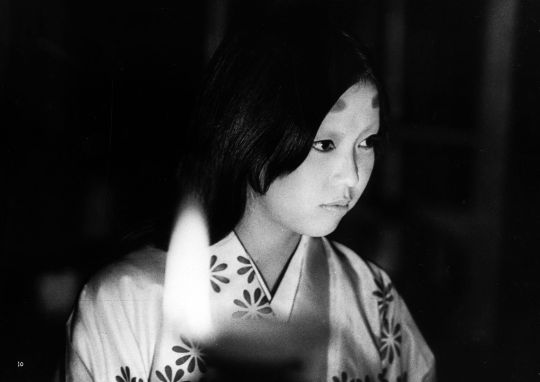
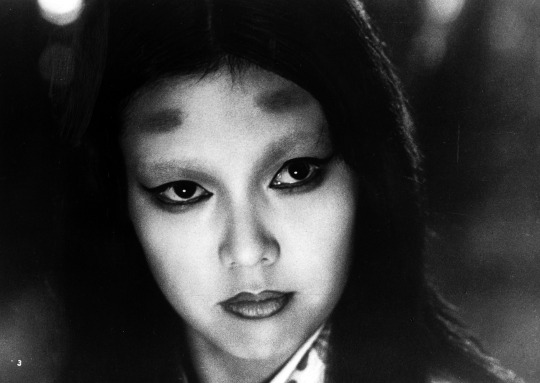
Kuroneko (藪の中の黒猫) (Yabu no naka no kuroneko) (Black Cat) (1968) Kaneto Shindô
March 17th 2024
#kuroneko#藪の中の黒猫#Yabu no naka no kuroneko#black cat#1968#Kaneto Shindō#Kichiemon Nakamura#Kichiemon Nakamura II#Kiwako Taichi#Nobuko Otowa#Kei Satô#A Black Cat in a Bamboo Grove#the black cat
0 notes
Text
'Koruneko' – a ferocious Japanese ghost story on Criterion Channel
‘Koruneko’ – a ferocious Japanese ghost story on Criterion Channel
The English title of Kaneto Shindo’s Koruneko (Japan, 1968) is Black Cat but this ferocious ghost story is not about cats but vengeful spirits.
Set in feudal Japan, in a bamboo forest perpetually shrouded in fog and shadow as ethereal as the ghosts themselves, the film chronicles the odyssey of two women (Nobuko Otowa and Kiwako Taichi) left alone to tend the family farm when the man of the…

View On WordPress
#1968#Blu-ray#Criterion Channel#DVD#Japan#Kaneto Shindo#Kichiemon Nakamura#Kiwako Taichi#Kuroneko#Nobuko Otowa#VOD
1 note
·
View note
Text
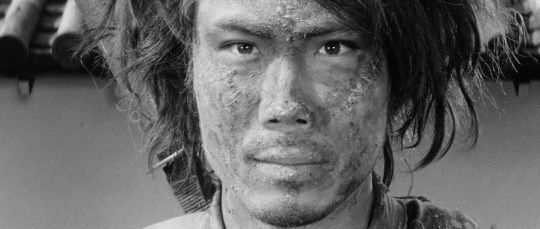


Nakamura Kichiemon II in Kuroneko (1968), dir. Kaneto Shindo
0 notes
Photo
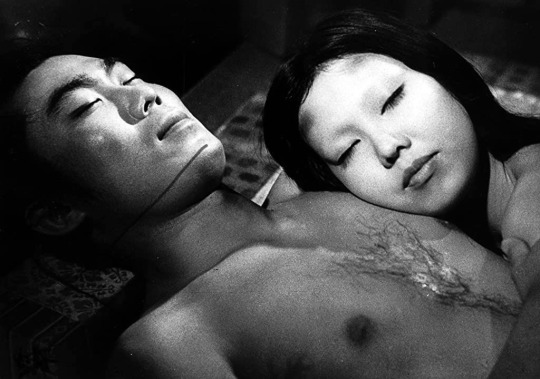
Kichiemon Nakamura and Kiwako Taichi in Black Cat, 1968
143 notes
·
View notes
Text

Nakamura Kichiemon I as Mitsuhide - Natori Shunsen (1925)
Kichiemon, a leading Taishö actor famous for his imperious scowl and proud glare, was well suited to the role of Mitsuhide in the historical play ""The Banner of Rebellion,"" about the tribulations of a royal retainer falsely accussed of treason.
By cropping the composition so that Mitsuhide seems ready to explode, Shunsen conveyed the psychic energy of the enraged warrior. Shunsen, using softly modulated colors in the naturalistic manner of the Maruyama-Shijö school of painting, adapted Western methods of life drawing rendered with light-colored lines that expressed the features of an actor's face more naturally.
#kabuki#japanese culture#japanese theatre#japanese art#ukiyoe#japan#natori shunsen#woodcut#woodblock#art
7 notes
·
View notes
Photo

Meiko Kaji (梶芽衣子) and Kichiemon Nakamura (二代目 中村 吉右衛門) in the first episode of the third Kiritsune Gomen (斬り捨て御免!) series, also known as License To Kill, 1982.
20 notes
·
View notes
Text
May 1st 1932 Tokyo, Japan: Charlie Chaplin (bow tie) and brother Sydney are entertained by Nakamura Kichiemon, famous Kabuki Theatre actor, during their visit to the Japanese Capitol.

March 6th 1936 Tokyo, Japan: Charlie Chaplin and Paulette Goddard took in a performance at a Kabuki Theatre.
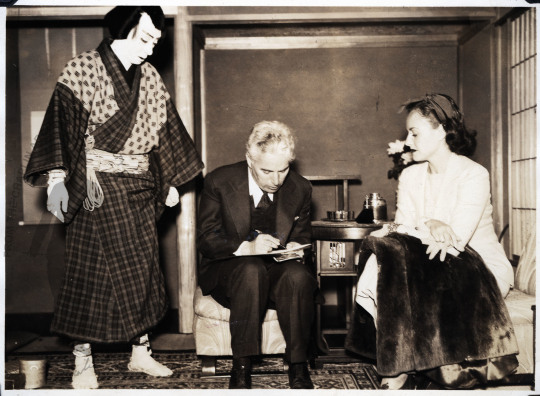

Charles Chaplin Jr. (1925-1968) wrote in his book published in 1960 "My Father, Charlie Chaplin" page 72 regarding Japanese people:
“They understand and love his pantomime, which has so much in common with the tradition of their own Kabuki theater. My father, for his part, fell in love with Kabuki style of acting, with its stress on pantomime, from the first time he saw a Japanese troupe performing in this (U.S.) country.”
#charlie chaplin#sydney chaplin#tokyo japan#may 1st 1932#paulette goddard#march 6th 1936#kabuki theatre
21 notes
·
View notes
Photo



Raincoats by Issey Miyake. The male version is modeled by Kabuki actor Kichiemon Nakamura.
The woman’s raincoat is photographed by Irvine Penn.
And then wearing a hood is Issey himself photographed by Penn too.
10 notes
·
View notes
Text
Not Made In the USA month : Kuroneko
During Not Made In the USA month I shall view the cinema of various countries ,barring the USA
Today we look at a Japanese ghost story
Warning film contains S*xual Assault

This 1968 film follows the spirits of Yone (Nobuko Otowa ) and Shige (Kiwako Taichi) who have vowed to kill and drink the blood of all samurai after they were r*ped and murdered by a group of samurai ,but things get complicated when Yone's son/Shiges husband Hachi (Kichiemon Nakamura ) comes back as a samurai with a mission to kill the spirits
So this movie is great .Now dont go into this expecting a top to bottom scare fest ,cause it is not that ,its more a movie you watch and feel a little creeped out the next time your walking in the dark or near the woods ,thinking there might be ghosts nearby .Its less of a horror film and more of an old fashioned ghost story you hear told round the camp fire ,more spooky then scary .I like that the monsters are pretty much our leads ,our sympathies are entire with the spirits ,and when Hachi enters the picture,it becomes what I feel a good horror story should be :A tragedy .We feel for these three characters and realize the samurai ,who are depicted as baragging bullies at BEST and brutish r*paing murderers at worst , are the true villains .This is also a movie that if you are a low budget filmmaker seeking to make a horror film,this is a must watch cause it does horror with simple tricks . Also very well paced for the most part
A bit spooky,with some romance and definataely some melancholly ,this is a very good ghost story I reccomend
@ariel-seagull-wings @metropolitan-mutant-of-ark @princesssarisa @the-blue-fairie
8 notes
·
View notes
Photo

中村吉右衛門 演劇界 1966年9月号臨時増刊
第二十四巻第十一号
演劇出版社
表紙=二代目吉右衛門・〈逆艪〉 樋口次郎兼光
#中村吉右衛門 演劇界 1966年9月号臨時増刊#kichiemon nakamura#中村吉右衛門#演劇界#二代目 中村吉右衛門#逆艪#樋口兼光#中原兼光#anamon#古本屋あなもん#あなもん#book cover
32 notes
·
View notes